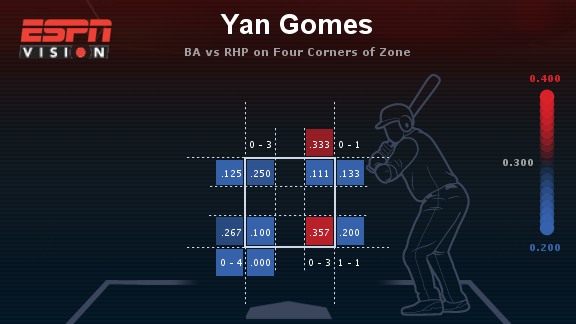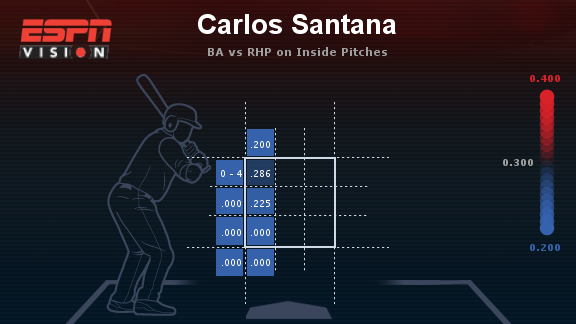Leading up to Opening Day, I will be profiling each member of the Indians 25-man roster (and disabled list) with mini scouting reports based on information gathered from ESPN Stats & Information.
And, just for fun, I’ll be sharing some custom baseball cards I’ve created as well. The cards feature the current players in the template of one of my personal favorite set of cards, 1993 Triple Play.
Up first, are the catchers and first basemen.
Yan Gomes – C

Versus Righties – Gomes hit just .256 with a .296 OBP against righties in 2014. He’s basically a replacement-level hitter against righties, handling mistakes down the middle but with holes everywhere else. Gomes hit .400 on pitches right down the middle of the plate against righties. But on pitches in any of the four corners, Gomes hit just .189 (see heat map below).
Basically if you’re a righty against Gomes, just don’t lay a fat one down the middle and you’ll do just fine.
Versus Lefties – Gomes terrorizes lefties with a .329 average and a .902 OPS since joining the Tribe in 2013. The key to success is the fact that he can hit everything. He has a .319 average against lefties fastballs and .352 against offspeed pitches.
Gomes is particularly deadly on pitches low in the zone. On all pitches down in the zone against lefties, Gomes hit .451 with a .608 slugging percentage in 2014.
Roberto Pérez – C
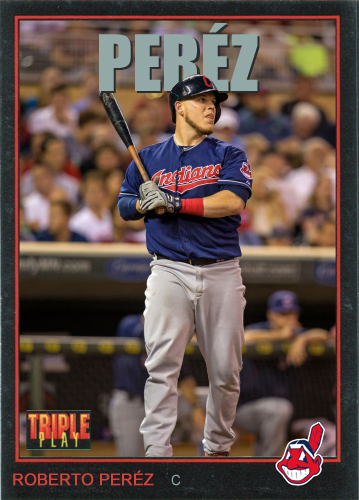 This is a tiny sample size for Pérez, as he had just 95 plate total appearances, so we’ll combine his report into just one overall review rather than splits for lefties and righties.
This is a tiny sample size for Pérez, as he had just 95 plate total appearances, so we’ll combine his report into just one overall review rather than splits for lefties and righties.
The primary issue for Pérez was simply making contact. He whiffed on 27 percent of his total swings in 2014—among Indians with at least 50 plate appearances last year, only Chris Dickerson and Zach Walters had a higher rate. Normally a high whiff rate correlates to a high chase rate, but Pérez only offered at pitches out of the zone on 25 percent of his swings, which is actually below the league average.
Like most young hitters, Pérez can handle a fastball (.350 average) but was essentially helpless on offspeed stuff (.171 average).
As far has holes in his swing, Pérez struggles with the outside pitch (see Heat Map below). He managed just a .133 average with a 33 percent whiff rate on outside pitches.
Carlos Santana – 1B
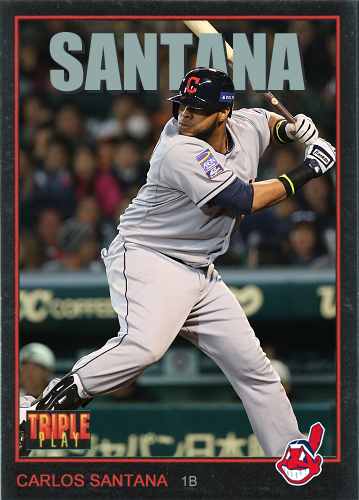 Versus Righties – It’s all or nothing for Santana against righties. He’s the ultimate three true outcome player, as 40 percent of his plate appearances against righties over the past two seasons have resulted in a strikeout, walk or home run.
Versus Righties – It’s all or nothing for Santana against righties. He’s the ultimate three true outcome player, as 40 percent of his plate appearances against righties over the past two seasons have resulted in a strikeout, walk or home run.
The issue for Santana against righties is the enormous hole in his swing (see Heat Map below). Amazingly, Santana has seen 524 low-and-inside pitches from righties over the past two years and has collected exactly ZERO hits. Additionally, he’s recorded a disturbing whiff rate of 52.6 percent.
Even if you expand the zone to all inside pitches, Santana has manged just 16 hits over the past two seasons, good for a .127 average.
Even when Santana does make contact, he’s an easy out against righties. Over the past two years, he pulled 59 percent of all balls in play against righties, the highest rate in the majors. In other words, the Santana shift isn’t going away any time soon.
Versus Lefties – Santana has a .286 average against lefties the past two seasons, but sees a considerable drop in power when he shifts to the right side of the plate.
On the right side Santana is basically the inverse of himself, as he destroys inside pitches, particularly fastballs. Against inside fastballs from lefties, Santana has a .333 average with a .474 slugging percentage the past two seasons.
The main reason for his success is simply due to the fact that there’s no obvious weakness for lefties to attack. His stats remain consistent across all zones and pitch types.
Nick Swisher – DH/1B
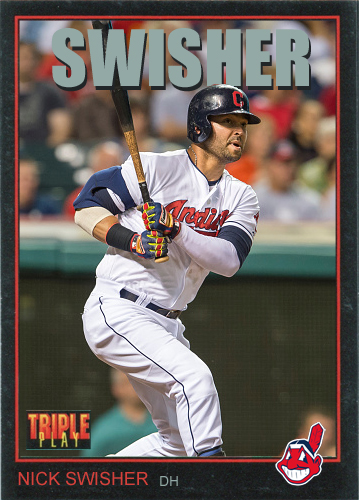 Versus Righties – Swisher can still makes righties pay for mistakes, but that’s about all he’s good for these days. Since joining the Tribe, Swisher has a .410 average with a .897 slugging percentage on fastballs down the heart of the plate but just a .208 average on all other pitches.
Versus Righties – Swisher can still makes righties pay for mistakes, but that’s about all he’s good for these days. Since joining the Tribe, Swisher has a .410 average with a .897 slugging percentage on fastballs down the heart of the plate but just a .208 average on all other pitches.
The key to beating Swisher is to simply work ahead in the count and bait him into chasing the offspeed stuff. In pitchers’ counts Swisher chases offspeed pitches outside the zone at a 30 percent rate, which leads to a .169 average.
His primary weakness is offspeed pitches down in the zone (see Heat Map below). Over the past two seasons, Swisher is 14-138 with 73 strikeouts in at-bats ending with a low offspeed pitch.
Versus Lefties – Swisher is a far more patient hitter from the right side of the play (he chases just 17.2 percent of pitches out of the zone). Even in pitchers counts, Swisher’s chase rate the past two seasons has been just 22 percent.
Additionally, Swisher’s contact rate against lefties (85.3 percent) is a whopping 16 percentage points higher than his rate against righties.
Swisher’s area of strength against lefties is up in the zone, where he has a .322 average .598 slugging percentage since 2013. Six of his 10 home runs against lefties came on pitches in the upper third of the zone (five of them on fastballs).



